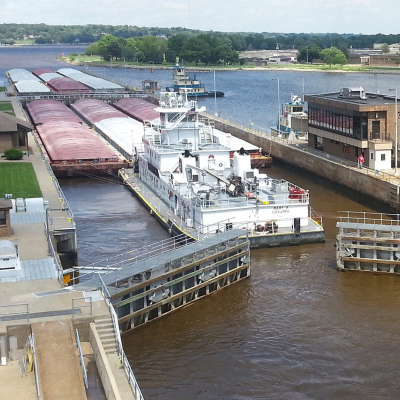In 1978, Congress charged the Upper Mississippi River Commission (predecessor organization to the Upper Mississippi River Basin Association) with preparing a comprehensive master plan for the management of the Upper Mississippi River System, in cooperation with federal, state, and local officials. The Commission transmitted the Comprehensive Master Plan to Congress in December 1981, and the organization was then terminated by Presidential Executive Order.
In the Comprehensive Master Plan, the Commission pointed to general recognition of the Upper Mississippi River System as a nationally significant ecosystem and a nationally significant commercial navigation system. The Commission also highlighted separate congressional authorizations that called for the system to be managed for two specific purposes: commercial navigation and national wildlife refuges. In addition to these two specific authorized purposes, the Commission found that the system provided a diverse array of other opportunities and experiences and recognized that “the viability of this multi-purpose system requires a commitment to maintain and enhance all aspects.” This sentiment is now the cornerstone for Upper Mississippi River management that strives to ensure the sustainability of the river’s incredible natural resources as well as its human uses. In working towards this goal, basin partners have established a rich tradition of working collaboratively to address basin management challenges.
Another Master Plan recommendation was for Upper Mississippi River System states to establish a cooperative arrangement to maintain coordination on management activities for water and related land resources. As a consequence, the governors of the five upper basin states formed the Upper Mississippi River Basin Association in December 1981. The Commission also recommended that Congress authorize certain navigation improvements as well as a “Habitat Rehabilitation and Enhancement Program” and a long-term resource monitoring program.
In the Upper Mississippi River Management Act of 1986, Congress approved the Comprehensive Master Plan as a guide for future water policy on the Upper Mississippi River system. The Act stated that “it is hereby declared to be the intent of Congress to recognize that system as a nationally significant ecosystem and a nationally significant commercial navigation system. Congress further recognizes that the system provides a diversity of opportunities and experiences. The system shall be administered and regulated in recognition of its several purposes.” In this legislation, Congress also authorized a program for habitat rehabilitation and enhancement as well as a long-term resource monitoring that is today known as the Upper Mississippi River Restoration Program or the Environmental Management Program – the first large river restoration and monitoring program of its kind in the nation.
Finally, in the Upper Mississippi River Management Act of 1986, Congress designated the Upper Mississippi River Basin Association as the “caretaker of the master plan.” As such, we are providing the “Comprehensive Master Plan for the Management of the Upper Mississippi River System” here for the reference of our basin partners. While some of the specific items addressed in the plan are obviously a product of the time in which they were developed and have subsequently been overtaken by intervening events, many of the plan’s recommendations are extremely relevant in understanding the genesis of current programs and institutional arrangements as well as how basin partners view the river system today.




